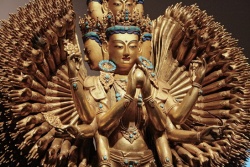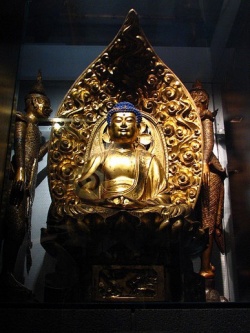Fourteen Fundamental Buddhist Tenets, as set forth in 1894
A Statement of Universal Buddhism
Buddhists are taught to show the same tolerance, forbearance, and love to all men, without distinction; and an unswerving kindness towards members of the animal kingdom.
The Universe functions according to Law (dharma), and not according to the caprice of a ruling god (isvara-deva).
The truths upon which the Dharma is founded are scientific. They have, we believe, been taught in successive ages (kalpas), or prehistoric epochs, by certain fully illuminated beings defined as human Buddhas (manushi-buddha).
The fourth World Teacher (shastara) of the present age was Buddha Sakyamuni, who was born in a noble family of the Sakya clan, in India about 2500 years ago. He is an historical personage, and his personal name was Siddhartha Gautama.
Sakyamuni taught that primordial Ignorance (avidya) produces Desire-to-be (trishna), unsatisfied Desire is the cause of life, and life results in old age, disease and death, i.e., Suffering (dukkha). To overcome Suffering, therefore, it is necessary to escape the Cycle of life and death; to escape the Cycle of life and death, it is necessary to extinguish Desire; and to extinguish Desire, it is necessary to destroy Ignorance.
Ignorance fosters rebirth on the Wheel of Necessity. When Ignorance is destroyed, the unsastisfactoriness of every such rebirth, considered as an end in itself, is perceived, as well as the paramount need of adopting a course of life by which the necessity for such repeated rebirths can be abolished.
The dispersion of Ignorance can be attained by the persevering practice of an all-embracing Altruism of Conduct, development of Wisdom, and Non-attachment for the transitory objects of ego-grasping.
Attaining Great Awakening (maha-bodhi), the Buddha Sakyamuni realized four profound insights: namely, that all created phenomena are impermanent; that due to the mutable impermanence of phenomena, all created phenomena must result eventually only in suffering; that there is no independent absolute 'I'; and that the seeker of Truth can transcend created existence and attain, through spiritual practice and mystical contemplation, a supreme state of peace called Nirvana.
Sakyamuni thus taught four Holy Truths (arya-satya), viz.
Worldly-existence is Suffering.
The Cause of Suffering is Desire.
The cessation of Desire results in the end of Suffering.
Cessation is obtained by following the eightfold Spiritual Path (arya-marga); viz., Right View, Right Thought, Right Speech, Right Action, Right Livelihood, Right Effort, Right Remembrance, Right Contemplation.
Right Contemplation leads to spiritual Awakening, or in other words the awakening of the Buddha-nature which is latent in every being.
The essence of Dharma, as summed up by the Buddha himself, is:
To refrain from all sin,
To practice virtue,
To purify the Heart
The Universe functions according to a natural law of causation known as "Karma". The wholesome and unwholesome actions of a being in past existences determine his condition in the present life. Each man, therefore, has prepared the causes of the effects which he now experiences.
The obstacles to the attainment of good Karma may be removed by the observance of the following precepts, which are embraced in the moral code of Buddhism, viz., Kill not, Steal not, indulge not in Harmful Sexual Conduct, Lie not, and do not Intoxicate oneself with stupefying drugs or liquor. Five other precepts, which need not be here enumerated, should be observed by those who would attain, more quickly than the average layman, the release of suffering and rebirth.
The Dharma discourages dogmatic credulity. Buddha Sakyamuni taught it to be the duty of a parent to have his child educated in science and literature. He also taught that no one should believe what is spoken by any sage, written in any scripture, or affirmed by any tradition, unless it accord with reason.
Feeling that there was a need for a basic statement of Fundamental and Orthodox Buddhist tenets, upon which all Buddhists throughout the world generally agree, this document was drafted in 1889, at the instigation of the Elder Sumangala, by Colonel H.S. Olcott and, with some modification, was then over the next several years signed by representatives of all the major schools of Buddhism. In 1891 Olcott handed a version of this document to Prince Esper Ukhtomsky, director of the Religious Department of the Ministry of the Interior of Imperial Russia, to meet the acceptance of the schools of Mongolia, Buryatia, Kalmykia, and Tibet, and (in its present form) for presentation to His Royal Highness Czar-Nicholas II of Russia. The signatories (between the years 1891 to 1894) of this document include the following:
Theravada Order: Signed on behalf of all the Buddhists of Ceylon by the venerable Sri Sumangala, supreme patriarch of Colombo and high-priest of Adam's Peak; the venerable Dhammarakhita, head of the Malwatte Vihara at Kandy; the venerable Yatawatte, head of the Asgiri Vihara at Kandy; the venerable Maligawe Suriyagoda Sonuttara, archivist at the Temple of the Relic at Kandy; the Vinaya-cariya Dhammalankara; and the venerable Vibhavi Subhuti of Waskaduwa.
Signed on behalf of the Buddhists of Bengal by the venerable Gunamegu Vinilankara, the patriarch of the Vihara of Cittagong.
Sarvastivada Order: Signed on behalf of the Buddhists of Japan by the supreme patriarch Sanada Seiko of the Zen School; the venerable patriarch Harutani Shinsho of the Tendai School; the venerable patriarch Shaku Genyu of the Shin Gon School; the venerable Sun-nyo of the Shin Gon School; the venerable patriarch Fukuda Nichiyo of the Nichiren School; the venerable patriarch Takehana Hakuyo of the Jodo School; the venerable Kira Ki-ko of the Jodo Seizan; the patriarch and venerable master Kono Rioshan of the Ji-shu School; and the venerable Ito Qanshyu of the Shin.
Signed on behalf of the Buddhists of China by the venerable patriarch Hsien Ming, grand abbot of the Kwang-tse Imperial Temple, Peking; the venerable Wang Tse Yu; and the venerable Kang Fu An.
Signed on behalf of the Buddhists of Mongolia by the VIIIth Bogdo-gegan, venerable Jetsundamba Khutukhu, of Da Khuree, Urga; the venerable Lama Euzon Pakshi of Deprung; the venerable Khambo Sonam Djigshitov; and other heads of monasteries throughout Buryatia and Kalmykia. Signed on behalf of all the Buddhists of Tibet by the venerable Bandido Khambo Lama Ngawang Lobzang Dorjieff, tsenzab of the venerable Gyalwa Tubten Gyamtso, the XIIIth Dalai Lama of Tibet.
We present this document as an excellent statement of the basic principles of Buddhist doctrine, universally accepted by all schools.


